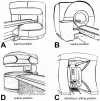Reduction of claustrophobia during magnetic resonance imaging: methods and design of the "CLAUSTRO" randomized controlled trial
- PMID: 21310075
- PMCID: PMC3045881
- DOI: 10.1186/1471-2342-11-4
Reduction of claustrophobia during magnetic resonance imaging: methods and design of the "CLAUSTRO" randomized controlled trial
Abstract
Background: Magnetic resonance (MR) imaging has been described as the most important medical innovation in the last 25 years. Over 80 million MR procedures are now performed each year and on average 2.3% (95% confidence interval: 2.0 to 2.5%) of all patients scheduled for MR imaging suffer from claustrophobia. Thus, prevention of MR imaging by claustrophobia is a common problem and approximately 2,000,000 MR procedures worldwide cannot be completed due to this situation. Patients with claustrophobic anxiety are more likely to be frightened and experience a feeling of confinement or being closed in during MR imaging. In these patients, conscious sedation and additional sequences (after sedation) may be necessary to complete the examinations. Further improvements in MR design appear to be essential to alleviate this situation and broaden the applicability of MR imaging. A more open scanner configuration might help reduce claustrophobic reactions while maintaining image quality and diagnostic accuracy.
Methods/design: We propose to analyze the rate of claustrophobic reactions, clinical utility, image quality, patient acceptance, and cost-effectiveness of an open MR scanner in a randomized comparison with a recently designed short-bore but closed scanner with 97% noise reduction. The primary aim of this study is thus to determine whether an open MR scanner can reduce claustrophobic reactions, thereby enabling more examinations of claustrophobic patients without incurring the safety issues associated with conscious sedation. In this manuscript we detail the methods and design of the prospective "CLAUSTRO" trial.
Discussion: This randomized controlled trial will be the first direct comparison of open vertical and closed short-bore MR systems in regards to claustrophobia and image quality as well as diagnostic utility.
Trial registration: ClinicalTrials.gov: NCT00715806.
Figures



References
Publication types
MeSH terms
Associated data
LinkOut - more resources
Full Text Sources
Medical

